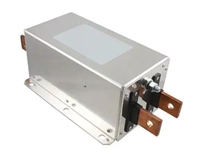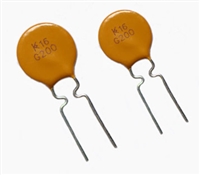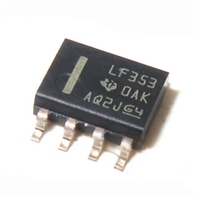LNK501
instead placed on the cathode side of D1, it would become a
switching node, generating additional common mode EMI
currents through its internal parasitic capacitance.
The extent to which R3 can be increased is limited by opto
transistor voltage and dissipation ratings and should be fully
tested before finalizing a design. The values of C2 and C3 are
less important other than to make sure they are large enough
to have very little influence on the impedance of the voltage
division circuit set up by R1, R3 and U1 at the switching
frequency. Normally, the values of C2 and C3 in Figure 6 are
chosen equal to the value of C2 in Figure 5, though the voltage
rating may be reduced depending on the relative values of R1
and R2 discussed above. See Applications section for typical
values of components.
The feedback configuration in Figure 6 is simply a resistive
dividermadeupofR1andR3withD1,R2,C1andC2rectifying,
filteringandsmoothingtheprimarywindingvoltagesignal.The
optocouplerthereforeeffectivelyadjuststheresistordividerratio
to control the DC voltage across R1 and therefore, the feedback
current received by the LinkSwitch CONTROL pin.
When the power supply operates in the constant current (CC)
region, for example when charging a battery, the output voltage
is below the voltage feedback threshold defined by U1 and
VR1 and the optocoupler is fully off. In this region, the circuit
behaves exactly as previously described with reference to
Figure 5 where the reflected voltage increases with increasing
output voltage and the LinkSwitch internal current limit is
adjusted to provide an approximate CC output characteristic.
Note that for similar output characteristics in the CC region,
the value of R1 in Figure 5 will be equal to the value of R1+R3
in Figure 6.
Figure 7 shows the influence of optocoupler feedback on the
output characteristic. The envelope defined by the dashed lines
represent the worst case power supply DC output voltage and
current tolerances (unit-to-unit and over the input voltage
range) if an optocoupler is not used. A typical example of an
inherent (without optocoupler) output characteristic is shown
dotted. This is the characteristic that would result if U1, R4 and
VR1 were removed. The optocoupler feedback results in the
characteristicshownbythesolidline.Theloadvariationarrowin
Figure7representsthelocusoftheoutputcharacteristicnormally
seen during a battery charging cycle. The two characteristics
are identical as the output voltage rises but then separate as
shown when the voltage feedback threshold is reached. This
is the characteristic seen if the voltage feedback threshold is
above the output voltage at the inherent CC to CV transition
point also indicated in Figure 7.
When the output reaches the voltage feedback threshold set by
U1 and VR1, the optocoupler turns on. Any further increase
in the power supply output voltage results in the U1 transistor
current increasing, which increases the percentage of the
reflected voltage appearing across R1. The resulting increase
in the LinkSwitch CONTROL current reduces the duty cycle
according to Figure 4 and therefore, maintains the output
voltage regulation.
Figure 8 shows a case where the voltage feedback threshold is
set below the voltage at the inherent CC to CV transition point.
In this case, as the output voltage rises, the secondary feedback
circuit takes control before the inherent CC to CV transition
occurs. In an actual battery charging application, this simply
limits the output voltage to a lower value.
Normally, R1 and R3 are chosen to be equal in value. However,
increasing R3 (while reducing R1 to keep R1 + R3 constant)
increasesloopgainintheCVregion,improvingloadregulation.
Output Voltage
Tolerance envelope
without optocoupler
Inherent
CC to CV
transition
point
Typical inherent
characteristic without
optocoupler
Voltage
feedback
threshold
VO(MAX)
Characteristic with
optocoupler
Power supply peak
output power curve
Load variation
during battery
charging
Characteristic observed with
load variation often applied during
laboratory bench testing
Output Current
PI-2790-112102
Figure 8. Output Characteristic with Optocoupler Regulation (Reduced Voltage Feedback Threshold).
I
5
2/05






 电子元器件中的网络滤波器、EMI滤波器与EMC滤波器:分类关系与功能详解
电子元器件中的网络滤波器、EMI滤波器与EMC滤波器:分类关系与功能详解

 NTC热敏电阻与PTC热敏电阻的应用原理及应用范围
NTC热敏电阻与PTC热敏电阻的应用原理及应用范围

 GTO与普通晶闸管相比为什么可以自关断?为什么普通晶闸管不能呢?从GTO原理、应用范围带你了解原因及推荐型号
GTO与普通晶闸管相比为什么可以自关断?为什么普通晶闸管不能呢?从GTO原理、应用范围带你了解原因及推荐型号

 LF353数据手册解读:特性、应用、封装、引脚说明、电气参数及替换型号推荐
LF353数据手册解读:特性、应用、封装、引脚说明、电气参数及替换型号推荐
